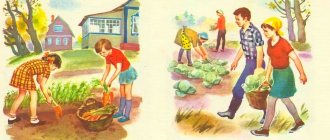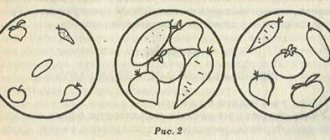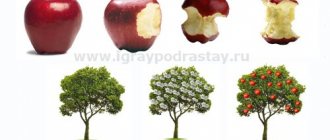Lexical and grammar lesson on the topic: “Vegetables”
Integration of educational areas:
- "Cognitive Development"
- “Socio-communicative development”,
- "Physical development"
Software tasks:
Speech development:
1. Consolidate and activate the vocabulary on the lexical topic “Vegetables”.
2. Exercise in the formation and use in speech of nouns with diminutive and augmentative meanings
3. Continue to teach how to answer the questions posed.
Cognitive development:
1. Develop observation, attention, thinking, coherent speech.
Social and communicative development:
1. Continue working to foster friendly relationships between children.
Physical development:
1. Develop fine motor skills of the fingers.
2. Develop the ability to coordinate speech with movements.
Equipment: subject pictures depicting vegetables, plot picture “Vegetable Garden”, vegetables (tomato, cucumber, cabbage, carrots, potatoes, onions, garlic, zucchini, eggplant, peppers, radishes, turnips, radishes, pumpkin).
Summary of a speech therapy lesson for children with special needs in the preparatory group. Vegetables
Summary of a speech therapy lesson for children with level 3 OHP in a pre-school group.
"Vegetables. We are harvesting." Author: Ryabina S. A., speech therapist MBOUNSHDS No. 48, city.
Noginsk. I offer a summary of a speech therapy lesson for children with OHP level 3 speech underdevelopment for children 6-7 years old.
This material will be useful to speech therapists working in correctional kindergartens and speech therapists working at speech centers. The abstract is aimed at forming and clarifying the vocabulary on this topic, the formation of lexical and grammatical structures. Objectives: 1. To consolidate ideas about vegetables; 2. Formation of word formation skills; 3. Correct and develop coherent oral speech; 4. Replenish passive and active vocabulary; 5. Give students an idea of where vegetables grow and how they are harvested. Equipment: Vegetables (pictures, dummies, natural, cut-out pictures, templates, stencils).
Lesson progress
1. Organizing the beginning of the lesson Checking readiness for the lesson, reporting the topic. 2. Updating and testing students’ knowledge on the topic “Vegetables”. Each child has a picture of a vegetable. Children name their vegetable and sit down. 3. Studying new material. Work on speech material. The speech therapist demonstrates vegetables, tells them what they are called, where they grow and how they are prepared. Students are involved in the conversation. On a magnetic board there are images of beds, pictures of vegetables. We plant vegetables in the beds. Children come to the board one by one, name the vegetable, and plant it in the garden. Further, the speech therapist emphasizes that each vegetable is harvested differently. Carrots, radishes, turnips, beets are pulled out. Cucumber, tomato, peas are removed, Potatoes are dug up. Cabbage, pumpkin, zucchini are cut off. The speech therapist asks questions to help you understand the material. Physical exercise One, two, three, four (marching), Children learned vegetables. Onions, radishes, zucchini, (they jump up, clapping their hands) Horseradish, carrots, garlic. 4. Consolidation of the studied material • Drawing up proposals. Demonstration of dummies, pictures or natural vegetables. The tomato is round, and the carrot... The radish is small, and the radish... The cucumber is oval, and the pumpkin... The zucchini is large, and the potatoes... The onion is bitter, and the peas... The cucumber is green, and the beets... Carrots grow in the ground, and the tomato... • “Call it affectionately” Education noun with diminutive suffixes. Cucumber - cucumber, Tomato - ... Peas - ... Pepper - ... Turnip - ... • “What will we cook?” Let’s make potato soup from potatoes, Make tomato soup from tomatoes, Onion soup from onions, Pumpkin soup from pumpkin. A conversation about what can be prepared from vegetables, what vegetables will become if they are frozen, pickled, boiled, stewed, fried, canned. • Development of fine motor skills. Outlining vegetables according to a stencil, template, modeling from plasticine, painting, shading. • Development of coherent oral speech skills. The story “Basket of Vegetables.” The speech therapist reads the story, and as the children read, they go to the board and insert the desired vegetable into the slot in the basket. Repeat each sentence, breaking it into two logical parts. Zina collected the harvest and put it in a basket. Here is a red tomato, a wonderful vegetable. Here is an oval cucumber, a great green one. Here is a beautiful carrot, a long braid. Here are delicious potatoes for soup and okroshka. • Psycho-speech gymnastics “Hide the syllables in your palms.” Children clap off the syllable structures of words: po-mi-dor, o-gu-rets, peas... • Compiling vegetables from cut-out pictures. Collect a vegetable, name it, come up with a descriptive story about it. • Making riddles about vegetables. • Summing up, answering the speech therapist’s questions (what topic was studied, name the vegetables, where and how they grow, what can be prepared from them, what are the benefits of vegetables).
We recommend watching:
Summary of educational activities in the preparatory speech therapy group. Summary of the frontal lesson in the preparatory group. Sound and letter AND GCD for teaching literacy to children in the preparatory school group “Sounds [B], [B]. Letter B" Summary of a speech therapy lesson on teaching literacy for children in the preparatory group
Similar articles:
Lesson summary on the topic “Musical Instruments” in the preparatory group
Summary of a lesson on speech development on the topic “Pushkin's Tales” in the preparatory group
Summary of a speech therapy lesson for children with ODD level III (senior group) on the topic “Vegetables”
Summary of a speech therapy lesson in a senior group on the lexical topic “Vegetables”
Prepared by a speech therapist teacher
Taran O.V.
Program content:
1. Expand and activate the vocabulary on this topic.
2. To develop children’s ability to agree nouns with adjectives in gender and number, to form nouns using diminutive suffixes).
3.. Develop visual attention, thinking, coordination of speech with movement, fine motor skills.
Materials:
Album on the topic “Vegetables”, models of vegetables, a ball, a Chipolino toy, plates of different shapes, coloring pages of vegetables.
I. Organizational moment
Hello guys! Today an unusual guest, the boy Chipolino, came to our lesson. He came to us from a magical land. In a clearing he found a bag containing unusual objects, let's help him!
The speech therapist shows models of vegetables, and the children name them.
Onions, cabbage, carrots, potatoes, cucumber, eggplant, pumpkin, beets, tomatoes, peppers.
Speech therapist. How can you call this in one word? (Vegetables)
II. Conversation and viewing of vegetables.
Speech therapist: Chipolino, look, these are vegetables, how different they are! Guys, let's determine the shape of each vegetable and put them on the right plates. We have round, oval and triangular plates.
Children take turns: Oval cucumber, round tomato, triangular carrot, oval eggplant, round pumpkin, round cabbage, triangular pepper, etc.
Speech therapist. Guys, where do vegetables grow? Where can Cipolino find them? (In the garden)
In autumn, vegetables are harvested from the gardens. People carefully remove them from the garden so as not to damage them.
Our guest invites us to play a game.
Game “Where do vegetables grow? "(on the ground, underground)
How to collect vegetables that grow on the ground, on a bush (plucked, cut)
How to collect vegetables that grow underground (dig, pull out)
The speech therapist shows pictures, the children make up a phrase:
Carrots are pulled, potatoes are dripped, cabbage is cut, peas are picked, beets are pulled, zucchini is cut, tomatoes are picked.
Well done boys! Look, our guest seems tired! Let's take a little rest.
Fizminutka
We chop and chop cabbage! (2 times)
(children imitate the chopping movements of an ax, moving their straight palms up and down)
We cut the cabbage, cut it! (2 times)
(move the edge of your palm back and forth)
We salt the cabbage, we salt it! (2 times)
(put your fingers together in a pinch and pretend to salt the cabbage)
We press the cabbage, press it! (2 times)
(vigorously clench and unclench your fists)
We three carrots, three! (2 times)
(we squeeze the right handle into a fist and move it up and down along the straight palm of the left hand, pretending to be a grater)




